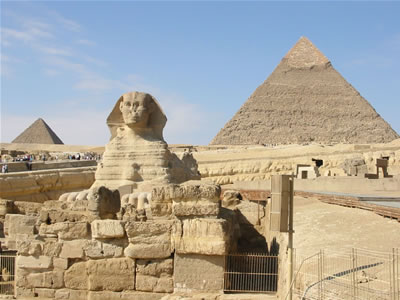The mystery of Pi in the pyramids of Egypt Part II
The scientists suggest that the use of ropes would be impracticable in these cases (the strings of these dimensions would break or change its length because of the enormous pressure to keep them in power). So, it is likely that the Egyptians used a diameter wheels royal cubit to measure distances, rolling them and counting the revolutions (each full rotation of the wheel).

And, as we saw in the example of the conference before, this is where Pi leaves his mark on the final measures. When the Egyptians wanted to measure the height of the pyramid, they just had to pile wheels above the other, and counted.
Theory seems very plausible and reasonable, and may explain the relationship between Pi and measures such as the pyramids of Cheops and Medum, so the theory has had great impact and has become the most widely accepted explanation on the subject. The problem is that it is valid to explain the other pyramids. For the pyramid of Khafre, this calculation gives a result of «3», while for that of Menkaure resulting value Pi is «3.26.» Values of Pi are not acceptable, and finally, of the 90 pyramids that exist in Egypt. The theory satisfactorily explains the action only two or three of them. So why accept a theory that explains only a very few pyramids, is not it likely that the ancient Egyptians built pyramids all similar techniques?
The angle of the pyramids:
There is an even simpler explanation for all this mystery, and it has to do with how the Egyptian engineers measured the angles. Was different from our current system of measuring the angle between two perpendicular planes, unknown to some ancient cultures. In the Egyptian case was based on measuring the horizontal distance of the slope required to reach the top of a royal cubit. This distance is measured in hands or fingers, and was needed more than 28 of them to cover it.

What happens then Pi? It turns out that the 1:22 ratio is very close to its value: 3.14285714 Chufus the pyramid, 3.142974 in the case of Cheops. The difference with respect to Pi is less than 0.00015! But probably no more than a coincidence, and is a measure of the actual bends of the fingers which causes it.
The factor that indicates that the ratio of Pi to the pyramids is probably a coincidence is that of the 90 surveyed Egyptian pyramids, there is considerable variation in their approaches to Pi of each other. If you really this mathematical concept had been known and used over 5,000 years ago, all the pyramids would have a much more similarity to approximate Pi. Of the 14 pyramids that have survived in good condition, 6 of them are built at an angle of 1:22 ratio, the ratio Pi.
Seems safer to believe that we are 90 pyramids with different approaches to the value of pi, which happens to be due to measurement system used in ancient Egypt, who believe that we have a pyramid built by the gods, Pi value almost perfect and another 89 pyramids of the same angles of which historical periods can not be explained in the same way.
What do you think?
Leave a Reply
You must be logged in to post a comment.
Recent Comments